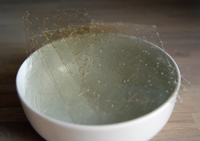
Photo from wikipedia
Strong mechanical performance, appropriate adhesion capacity, and excellent biocompatibility of conductive hydrogel-based sensors are of great significance for their application. However, conventional conductive hydrogels usually exhibit insufficient mechanical strength and… Click to show full abstract
Strong mechanical performance, appropriate adhesion capacity, and excellent biocompatibility of conductive hydrogel-based sensors are of great significance for their application. However, conventional conductive hydrogels usually exhibit insufficient mechanical strength and adhesion. In addition, they will lose flexibility and conductivity under subzero temperature and a dry environment owing to inevitable freezing and evaporation of water. In this study, a tough, flexible, self-adhesive, long-term moisturizing, and antifreezing organohydrogel was prepared, which was composed of gelatin, zwitterionic poly [2-(methacryloyloxy) ethyl] dimethyl-(3-sulfopropyl) (PSBMA), MXene nanosheets, and glycerol. Natural gelatin was incorporated to enhance mechanical performance via the entanglement of a physical cross-linked network and a PSBMA network, which was also used as a stabilizer to disperse MXene into the organohydrogel. Zwitterionic PSBMA endowed the organohydrogel with good adhesion and self-healing properties. Long-term moisturizing properties and antifreeze tolerance could be achieved owing to the synergistic water retention capacity of PSBMA and glycerol. The resulting PSBMA-gelatin-MXene-glycerol (PGMG) organohydrogel exhibited high mechanical fracture strength (0.65 MPa) and stretchability (over 1000%), excellent toughness (3.87 MJ/m3), strong and repeated adhesion to diverse substrates (e.g., paper, glass, silicon rubber, iron, and pig skin), good fatigue resistance (under the cyclic stretching-releasing process), and rapid recovery capacity. Moreover, the PGMG organohydrogel showed good stability under -40 °C. The sensor based on PGMG organohydrogel could tightly attach to the human skin and real-time-monitor the motions of joints (e.g., bending of the finger, wrist, elbow, and knee) and the change in mood such as smiling and frowning. Therefore, PGMG organohydrogels have a huge potential for wearable sensors under room temperature or extreme environments.
Journal Title: Biomacromolecules
Year Published: 2022
Link to full text (if available)
Share on Social Media: Sign Up to like & get
recommendations!